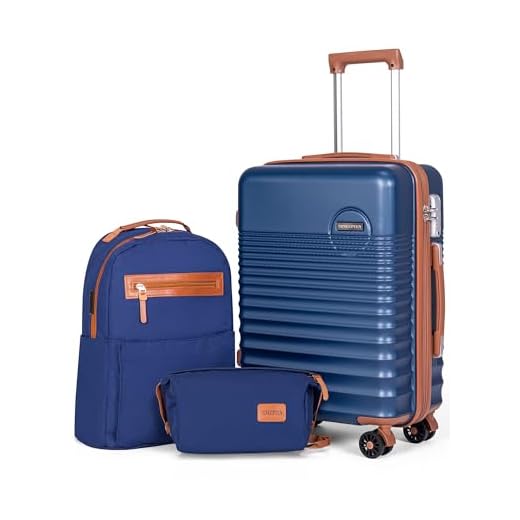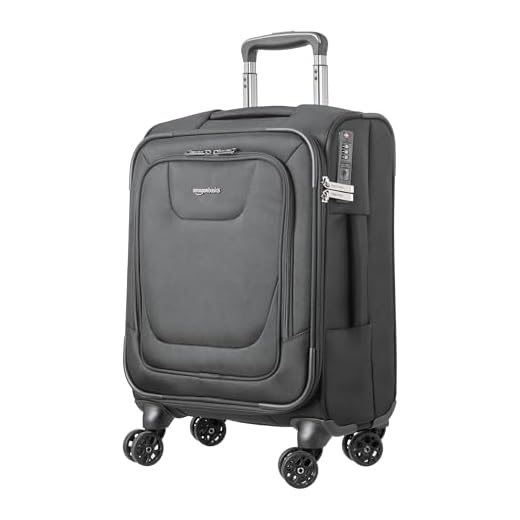





Most airlines set limits on baggage based on ticket type. Typically, passengers purchasing entry-level fare can expect stricter guidelines. Often, only a single carry-on is permitted, usually not exceeding dimensions of 22 x 14 x 9 inches and a weight cap around 15-20 pounds. Checked baggage may incur extra fees, sometimes exceeding $30 per bag.
Understand specific airline rules before traveling. For instance, American Airlines and Delta maintain similar carry-on specs, while United may differ slightly. Always verify policies on the airline’s official website prior to departure to avoid surprises.
Consider maximizing space with versatile packing strategies. Compression bags and organizing cubes allow efficient use of carry-on space, while ensuring compliance with size restrictions. Check-in items need planning; pack essentials within the carry-on in case of unexpected delays or baggage mishaps.
In conclusion, carefully familiarizing oneself with airline-specific baggage policies can lead to a smoother travel experience. Always pack smart and stay informed to ensure a hassle-free trip.
Maximum Weight Limit for Basic Economy Baggage
The maximum weight allowance for checked bags in this fare category typically stands at 50 pounds (23 kilograms). Exceeding this limit may result in extra fees, often around $100 per additional 10 pounds (4.5 kilograms).
For carry-on items, weight limits can vary by airline, often capping at around 15 to 25 pounds (7 to 11 kilograms). Some airlines do not impose a weight restriction but may enforce size limits, with dimensions usually set at 22 x 14 x 9 inches (56 x 36 x 23 cm).
Recommendations
- Weigh your baggage before heading to the airport to avoid unexpected fees.
- Use a lightweight suitcase to maximize your packing capacity.
- Consider redistributing weight between checked and hand-carried items to meet limits.
Extra Charges
Always check your airline’s specific policies, as discrepancies in maximum allowances and fees can lead to higher costs. Preemptively paying for additional weight may offer savings compared to paying at the airport.
Number of Bags Allowed in Basic Economy
Travelers booking a basic fare typically can bring one carry-on item and one personal item onboard. The carry-on should fit within specified dimensions, often around 22 x 14 x 9 inches, while the personal item is usually smaller, like a backpack or purse that fits under the seat in front of you.
Important Tips
Check individual airline policies, as each may have different regulations concerning sizes and permitted items. Sticking to guidelines can prevent last-minute fees or complications at the gate. Compact options like a best messenger bag for international travel can enhance packing efficiency.
Additional Considerations
Some carriers allow a small bag for essentials, but this may vary. Confirm specific allowances before heading to the airport to avoid surprises. Utilize versatile packing solutions to maximize space and stay within limits.
Carry-On Restrictions for Basic Economy Passengers
Each traveler in this fare category may take one personal item and, depending on the airline, a carry-on bag. The dimensions for a personal item typically should not exceed 18 x 14 x 8 inches (45 x 35 x 20 cm). This item must fit under the seat in front of you.
Airline-Specific Carry-On Guidelines
Many airlines impose specific regulations regarding carry-on baggage based on the fare type. It’s essential to verify your carrier’s website for precise information to avoid surprises at check-in or boarding.
| Airline | Personal Item Dimensions | Carry-On Restrictions |
|---|---|---|
| Delta | 18 x 14 x 8 inches | One personal item allowed, no standard carry-on for Basic Economy. |
| United | 9 x 14 x 22 inches | One carry-on allowed with purchase of Basic Economy fare. |
| American Airlines | 18 x 14 x 8 inches | Personal item only, carry-on must be purchased. |
Additional Considerations
Keep in mind that oversize bags can lead to additional charges. Always measure your items beforehand. Traveling light minimizes hassle and conforms to these regulations, ensuring a smoother airport experience.
Checking Bags: Fees and Policies for Basic Economy
Checked items typically incur additional charges with a basic fare. Expect to pay fees that vary by airline and destination. Always verify specific prices before booking your flight, as they can change based on timing and route.
Most carriers allow a single piece for a fee, with charges increasing for any excess. To avoid surprise expenses, consider pre-paying during ticket purchase or using an airline app for discounts.
Weight limitations often fall around 50 pounds per bag. Exceeding this limit may lead to extra charges, which highlights the importance of confirming weight before heading to the airport. Use a reliable scale to ensure compliance.
Direct inquiries with your airline’s customer service can clarify any ambiguities. Also, check specific policies on size and weight restrictions as they can differ widely across airlines.
If you’re traveling with a pet or other special items, additional fees may also apply. Review your carrier’s pet policy to understand conditions and costs. Always plan accordingly to guarantee a smooth boarding process.
For business trips, consider tools like the best umbrella for business man to ensure you’re prepared for any weather. Likewise, if you’re adopting a pet during your travels, look into the best adoption place for dogs in the tri state area to streamline the process.
Comparative Baggage Allowances: Basic Economy vs. Other Classes
Travelers in basic fare classes typically face stricter constraints compared to those flying in premium tiers. In general, premium cabins permit more and heavier bags without incurring extra charges, making them appealing to frequent flyers or those with extensive packing needs.
Premium Class Advantages
First-class and business passengers often enjoy generous accommodations, including multiple checked items and higher weight limits. Most airlines provide at least two free checked pieces, typically weighing up to 70 pounds (32 kg) each, contrasting sharply with the limitations placed on lower-tier travelers.
Economy Comparisons
Standard economy sections present a middle ground, offering moderate provisions: one or two free checked bags, often capped at 50 pounds (23 kg) per piece. Carry-on privileges are generally similar across all classes, yet the number of free pieces varies significantly, with basic fare options frequently restricting these allowances. Confirm airline specifics to avoid unexpected fees.
Tips for Packing Light in Basic Economy
Utilize packing cubes to organize your items efficiently. This allows you to maximize space in your bag and easily find what you need without unpacking everything.
Choose versatile clothing that can be mixed and matched. Lightweight fabrics that don’t wrinkle help save space and keep you looking sharp throughout your trip.
Layer your outfits instead of packing bulky items. A lightweight jacket or sweater can be worn on the plane and adds minimal weight while providing warmth.
Limit footwear to one or two pairs that match multiple outfits. Wear the heavier pair during your flight to save weight in your bag.
Consider travel-sized toiletries instead of full-size products. These can be stored in a small, clear bag to meet carry-on regulations while keeping you within limits.
Roll your clothes instead of folding them. This technique not only saves space but also helps minimize wrinkles, keeping your attire looking fresh.
Pack only the essentials by creating a list before you start. Prioritize items that you will definitely need, reducing the temptation to overpack.
Invest in a lightweight, durable bag that complies with size restrictions. Ensure it has multiple compartments to help with organization and accessibility during your flight.
Use empty space effectively; fill shoes with socks or accessories. This prevents items from shifting during transit and maximizes volume.
Check your airline’s specific limits ahead of time to avoid surprise fees and ensure compliance. Regularly review any updates to policies that might affect your travel planning.







